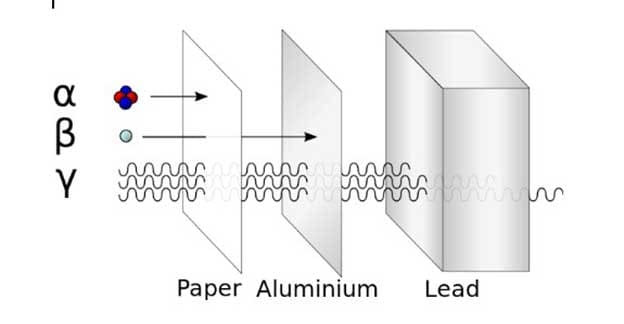
Radiation is energy travelling through space. Light, heat, microwaves and wireless communications are all forms of radiation. The kind of radiation discussed here is called ionising radiation because it can produce charged particles (ions) in matter. Background radiation is that ionizing radiation which is naturally and inevitably present in our environment. Levels of this can vary greatly. People living in granite areas or on mineralised sands receive more terrestrial radiation than others, while people living or working at high altitudes receive more cosmic radiation. A lot of our natural exposure is due to radon, a gas which seeps from the Earth's crust and is present in the air we breathe. Radiation exposure is a part of everyday life. Radiation effects may appear following exposure to high doses in a short time, just as a bad dose of sunburn results from too much exposure to sunlight too quickly. Similarly, long term exposure to ionising radiation at high levels may cause permanent damage to the body. That is what happened to the firefighters and plant worker just after the accident.
Chernobyl exclusion zone is an area in Ukraine that was badly contaminated by radioactivity as a result of the explosion of the reactor number 4 of Chernobyl Nuclear Power Plant. Mainly plutonium-239, strontium -90 and cesium -137 were present in the area. Today the radioactive pollution is made up mostly of strontium -90 and cesium -137 – they have a 30-year disintegration half-life. Isotopes of plutonium and americium will be present is the area for several thousand years. A radioactive atom of any of these elements is unstable because it contains extra energy. When this atom ‘decays’ to a more stable atom, it releases this extra energy as ionising radiation. However, over 600 000 people were involved in the clean-up of radioactive fallout. These heroes reduced the level of radiation a lot and made the area safe to visit. Plus, radioactivity naturally diminishes with time. Much of the radioactive isotopes have gone deeper into the soil.
There are highly contaminated and hazardous areas in the exclusion zone nowadays, but they are far away from the tour roots. This is one of the reasons why people can not live there, but it is possible to visit the site. Another reason is a time issue. It is absolutely safe to visit the area for a short period of time, but prolonged, careless stay may cause damage to our health.
There are three types of nuclear radiation - alpha, beta and gamma. Alpha is the least penetrating, while gamma is the most penetrating. Alpha particles (helium nuclei) may be stopped by paper, beta rays (high speed electrons) are stopped by perspex, while gamma rays (like X-rays) may need lead or concrete to stop them. Alpha radiation travels only a few centimetres in air, beta radiation travels tens of centimetres in air, while gamma radiation travels many metres. All types of radiation become less intense the further the distance from the radioactive material is, as the particles or rays become more spread out.

During a trip to Chernobyl zone, a person is exposed to radiation impact that may consist of two types of ionizing radiation gamma-rays and β particles. A dose of gamma radiation received during one full day in the zone is 2 microsieverts and it is equal to a 1-hour flight (space radiation is the same gamma radiation as presented in the Chernobyl zone, and it only differs in origin) and 3000 times less than a CT scan. A safe limit is 100 microsieverts per day.
Visitors of the exclusion zone have some contact with beta radiation only closer to the reactor and measuring some of the so-called “hotspots” but for only a short amount of time. And contacts with the most dangerous alpha radiation are almost impossible during your tour.
During a visit to the zone, you should be aware of radioactive dust, which might appear in some places and land on your clothes or shoes. That is why it is highly recommended to wash your clothes when you return home.
Since none of our five senses of sight, hearing, touch, taste or smell enables us to detect ionising radiation, we suggest getting an appropriate instrument such as a for your tour. Only such devices can make radiation visible and help you to stay safe.
